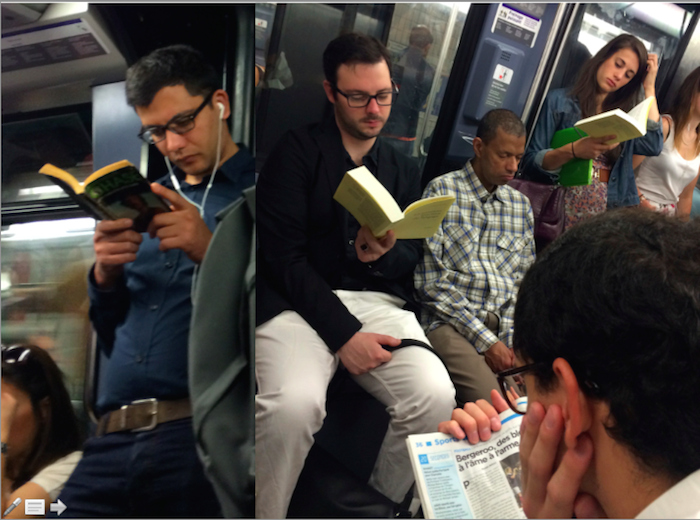In 2008, I read all seven volumes of Remembrance of Things Past on my iPhone. The experience, a journey into Proustian territory that lasted eighteen months, a first of its kind for me (it rates up there with driving across the United States at the wheel of a 1956 Ford pickup truck in the summer of 1980).
Today, I read printed books. Paper nostalgia is part of it, but it’s not the only reason. Electronic gadgets are no longer what they used to be: they’ve become surveillance devices. The way they shine light directly on your face is reminiscent of old police interrogation tactics. I prefer traditional books—they are not, like Amazon.com, trying to collect information on me.
Privacy issues aside, it is becoming increasingly evident that reading on a backlighted monitor—computer screens, smartphones, or tablets—has a disruptive effect on our cognitive functions. Clinical studies confirm that the majority of people have trouble recalling what they read on a screen. The constant browsing, scrolling, and keyword tracking that characterize our online culture is probably the main culprit. Colorful visuals, icons, and images add a layer of complexity that further derails our original intent.

The digital age has us believe that we are pioneers of communication. In fact, the problems we encounter are nothing new. Backlighted images were already a cause for great concern when stained glass windows were introduced in cathedrals in France in the twelfth century. A feature of Gothic architecture, the innovation was so momentous, culturally and psychologically, that it fueled a debate that polarized the scholarly world for a century.
Religious authorities—among them Bernard de Clairvaux, founder of the monastic Cistercian order—objected to the bright colors that spilled light directly in the face of worshipers as they stared in awe at the immense stained glass windows of the great cathedrals of the period: Chartres, Paris, Reims, Strasbourg. It was as if the source of divine light was suddenly beamed from above, pointing down at you, claiming your attention. What we now call the “cathedrals of light” were in fact scintillating magic lanterns, hypnotic venues attracting flocks of rubbernecking pilgrims.
With handheld electronic devices you don’t have to crane your neck, a major advantage. Otherwise, the narrative power of the bright colorful visuals is the same. In both cases, viewers are taken hostage by the incandescent beauty of these images.
In contrast, the Cistercian sanctuaries, built in smooth white stones with fewer windows, were designed to be monochrome environments bathed in soft illumination. There, divine light was experienced as a bouncing presence, diffuse yet pervasive, seamlessly reflected by all things. To this day, stepping inside one of these radiant churches—Le Thoronet, Sylvacane, Sénanque—is like entering a part of oneself that is free from distractions.
It’s the next best thing to cracking open a good book.
